An independent study on creative performance and audience attention based on YouTube FMCG Cleaning-Products Ads, Q4 2021
Introduction
As the world’s largest video platform, YouTube excels at capturing attention. Every day, people watch multiple billions of videos, generating a view time of 1 billion hours. YouTube monetizes much of that attention through short preroll and midroll videos, often with a 6-second unskippable ad, as well as up-to-15-second ads viewers can skip within the first few seconds.
Companies advertise on YouTube because of the quality of audience attention and extensive reach. Once an attentive audience is accessed through YouTube, advertisers must ensure the video ad creative captures and retains attention, and then encodes the brain through emotional response. According to Nielsen Catalina Solutions (NCS), creative is advertising’s biggest driver of sales at 47%.
How can brand leaders transform brand advertising into performance advertising?
Some advertisers, such as those in the eCommerce and direct-to-consumer space, can measure success with direct response calls-to-action (CTA).
However, brand advertisers, such as in the fast-moving consumer goods (FMCG) category, have latent business outcomes, which are more difficult to attribute to advertising investment.
If you can track attention and emotional response, you can identify quality impressions that demonstrate advertising efficacy. Pre-testing creative for attention allows you to understand efficacy and optimize a campaign long before it even flights.
Unfortunately during the pandemic, cleaning supplies were top-of-mind for most consumers as they grew concerned about the outside world potentially bringing COVID-19 into their houses. Homebound and confined to watching TV and Internet videos, a lot of business was accessible to the cleaning supplies company that captured the most attention and emotional response.
To help FMCG companies harness creative attention in digital video, we tested a portfolio of videos from prominent brands, sourced from YouTube, in the sub-category of home-cleaning supplies.
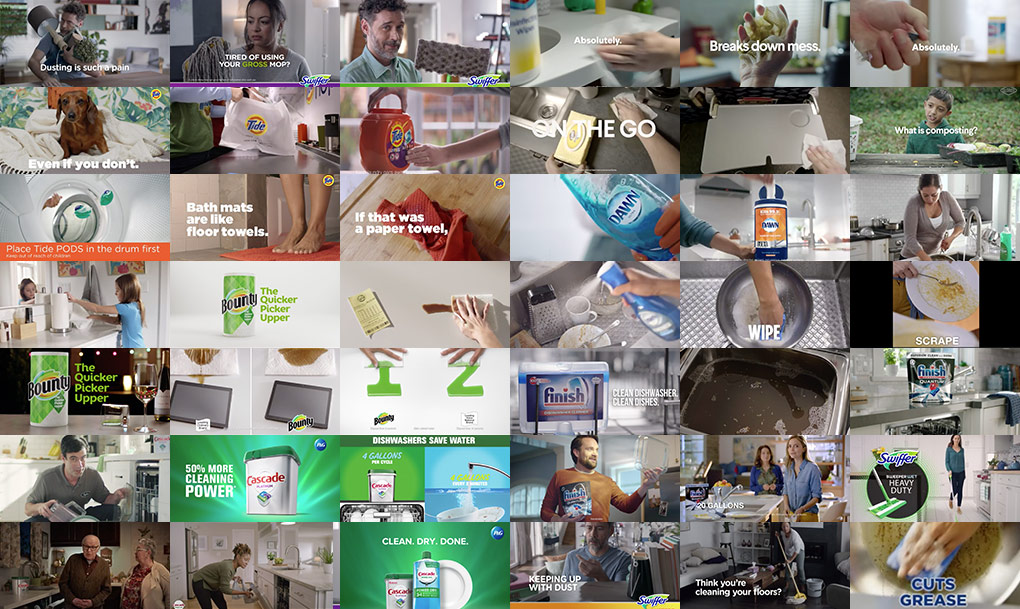
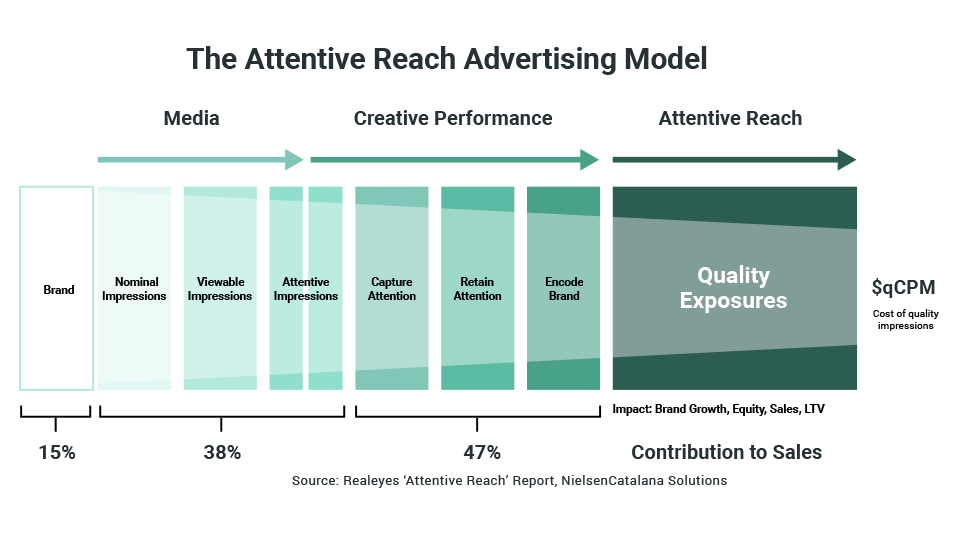
What You Need to Know
Created by Keith O’Brien, Colin Pye & Ben Seslija| Q4 2021
Skip the Generic Cleaning Tutorial
Viewers know and perhaps don’t want to be reminded of what it’s like to clean with an inferior product. You should either lead with a demonstration of the advertised product or only show a comparison to the inferior competition on a split screen. Actors demonstrating the pain of cleaning can dramatically reduce attention to the point of never being able to win back the audience – up to 25% in some cases.
Adapt to Mobile Context
Video creatives viewed on mobile, compared to desktop, struggled to gain attention and drive an emotional response. The average Realeyes Quality Score for creatives viewed on desktop was 4.8 out of a possible 10, significantly higher versus the same videos viewed in a mobile environment at 3.8. On average, in almost every category, desktop outperformed mobile. However, videos that quickly addressed the audience’s cleaning needs scored well within a mobile context.
Show the Human Side
The presence of humans in YouTube video advertising increased audience retention by 5% on average.
Short for Attention & Emotional Response
On desktop and mobile, the top 21 ads based on attentive audience Retention were all of a 6-second duration. And Unlike videos in other product categories, Encode scores, which reflects emotional response while paying attention, increased by 40% for ads that lasted six seconds versus those that lasted 15 seconds. The difference was even more pronounced on mobile at 63%.
Optimize by Device
Many ads stood out by performing much better in one device format versus another. Among our total portfolio of 42 ads, 16 had a ranking difference of 20 places between mobile and desktop based on Realeyes Creative Efficiency Score, which indicates how well an ad leverages paid media to achieve quality exposures.
Not all ads performed equally as well across desktop and mobile devices. To eliminate doubt and to ensure optimal performance, it’s best to test your ads beforehand on both devices to see which outperforms baseline norms.
Human Presence Retains Attention, While Human Behaviors Elicit Key Emotions
Lingering packshots placed on kitchen work surfaces without any people present pose the risk of distraction. A human presence in any scene (with or without the product) increased audience retention by an average of 5% across the 42 ads within this study.
Historically, actors have been used to play out scenarios demonstrating the hassle of cleaning with an inferior product, followed by an effortless and effective cleaning scene using the brand being advertised. But our study found that audiences are less prepared to watch the arduous scene-setting to heighten the contrast of the product’s effectiveness later on.
A human presence in scenes (with or without the product) increased audience retention by an average of 5%
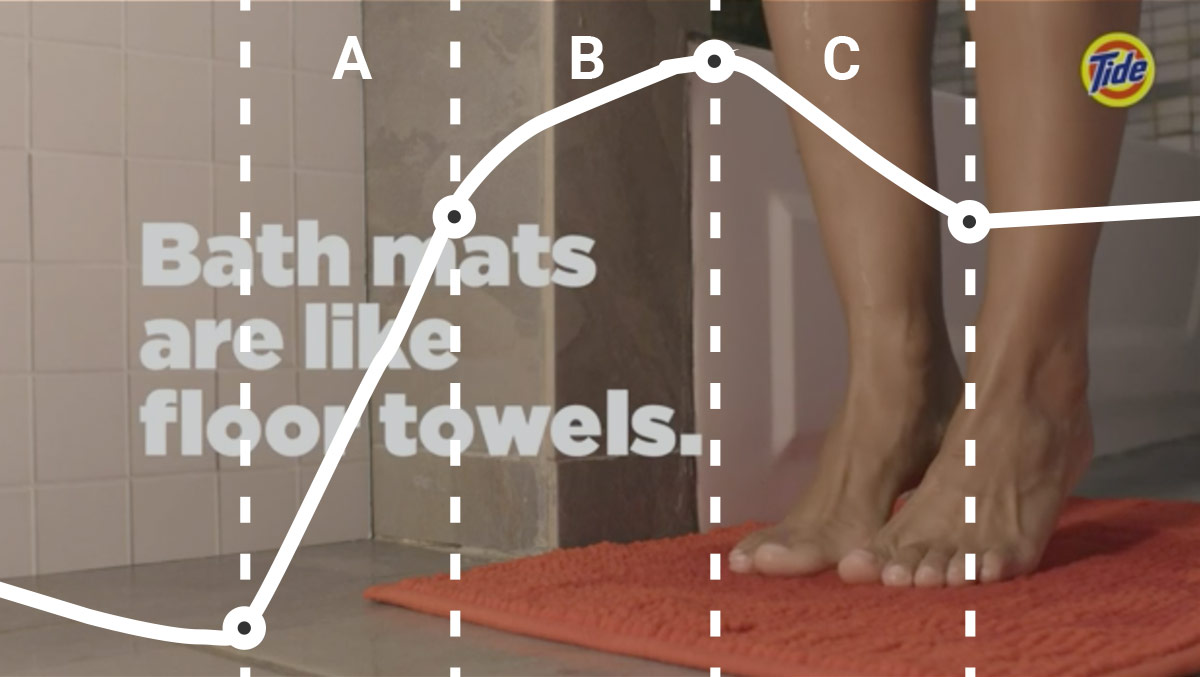
Even the presence of hands or feet can raise attention. In Tide’s ‘Bath Mats,’ attention increases (A) as the feet walk in, (B) toes wiggle and (C) attention decreases as they walk out of frame.
In Cascade’s 15-second ‘Do it Every Night’ ad (below), we see that Happiness increases from the first second by 4.7% as we’re introduced to the couple. Happiness wanes once the scene switches to the packshot and only increases once a hand reaches for the pack before the end brand sting.
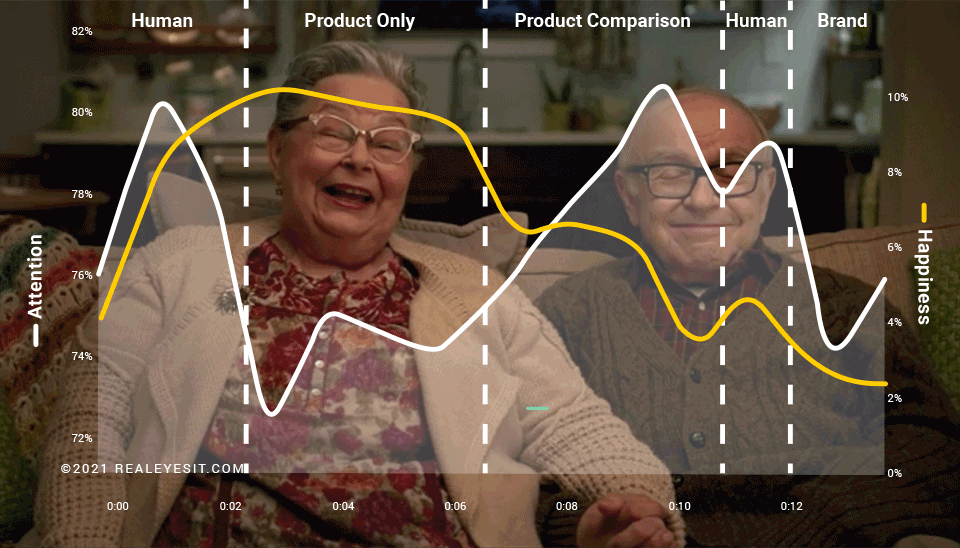
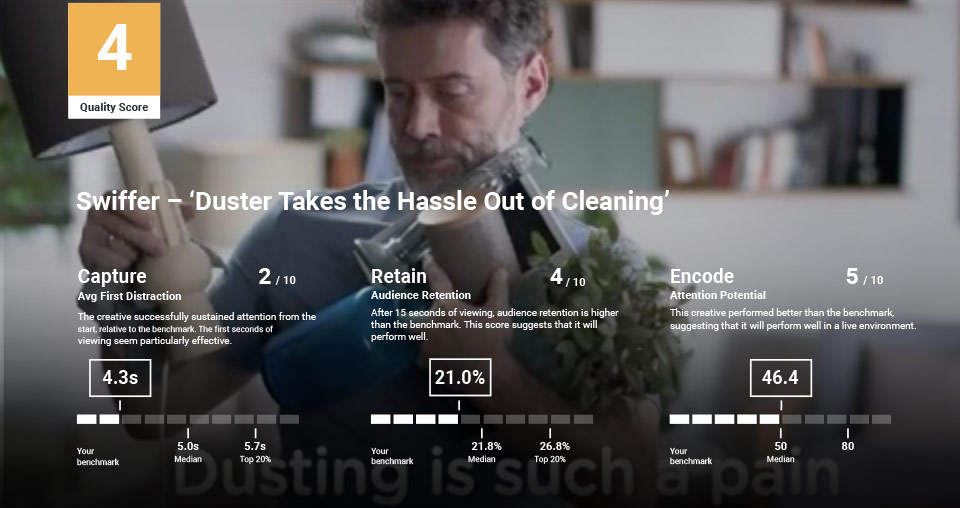
Swiffer – ‘Duster Takes the Hassle Out of Cleaning’
In the Swiffer video “Duster Takes the Hassle Out of Cleaning,” where the actor demonstrated the pain of dusting with a rag, which was intended to serve as a contrast to using a Swiffer. But on both desktop and mobile, attention dropped sharply to under 25% when the scene was introduced and never recovered.
It is hard to reestablish attention once it’s been lost and b) people don’t need to be reminded of the effort of cleaning with a bad product.
Threading the needle is possible. One solution to compare products is by showing them side-by-side so attention remains strong, the contrast is apparent, and the ad showcases the ease of using the product advertised.
attention dropped sharply to under 25% when the scene was introduced and never recovered
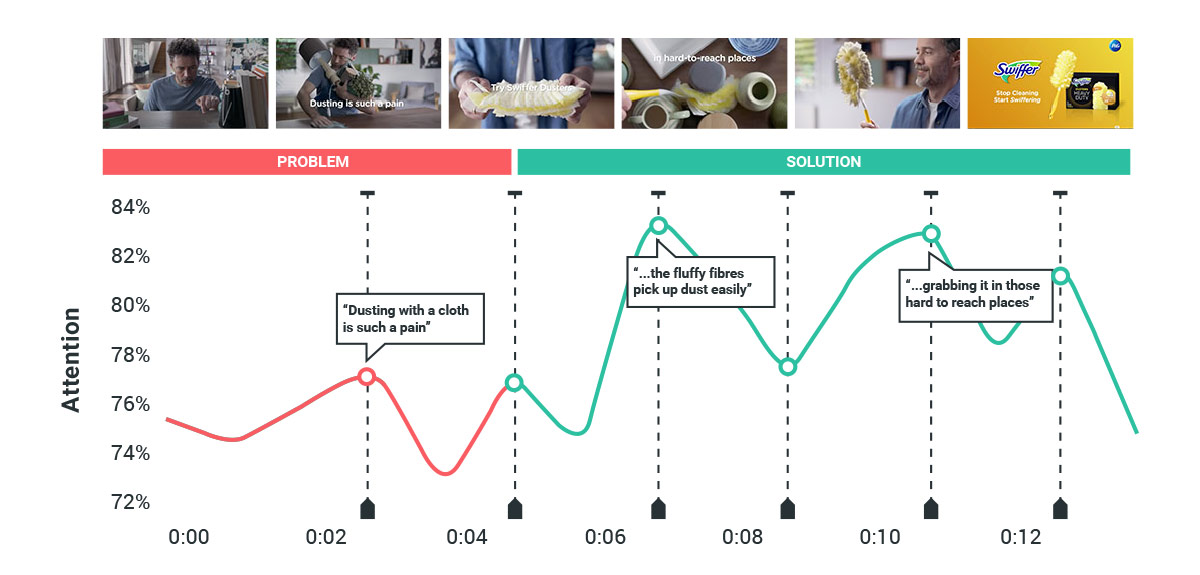
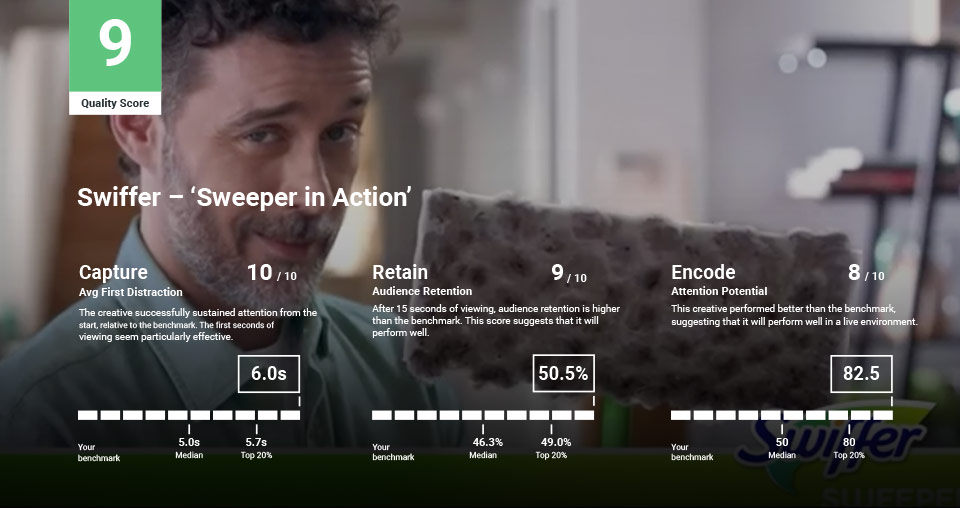
Swiffer – ‘Sweeper in Action’
The 15-second ad that retained the most attention on mobile, Dawn’s Platinum Makes Quick Work, introduced the product early and had a pervasive side-by-side comparison throughout the ad. By second 9, the ad had retained 44% of the attention, nearly one-third the average of 15-second ads on mobile devices.
There was also a correlation between disgust and attention. Unsurprisingly, the cleaning goods category had one of the highest percentages of disgust. But this is by design. To demonstrate the efficacy of the product is to show the mess it needs to clean up.
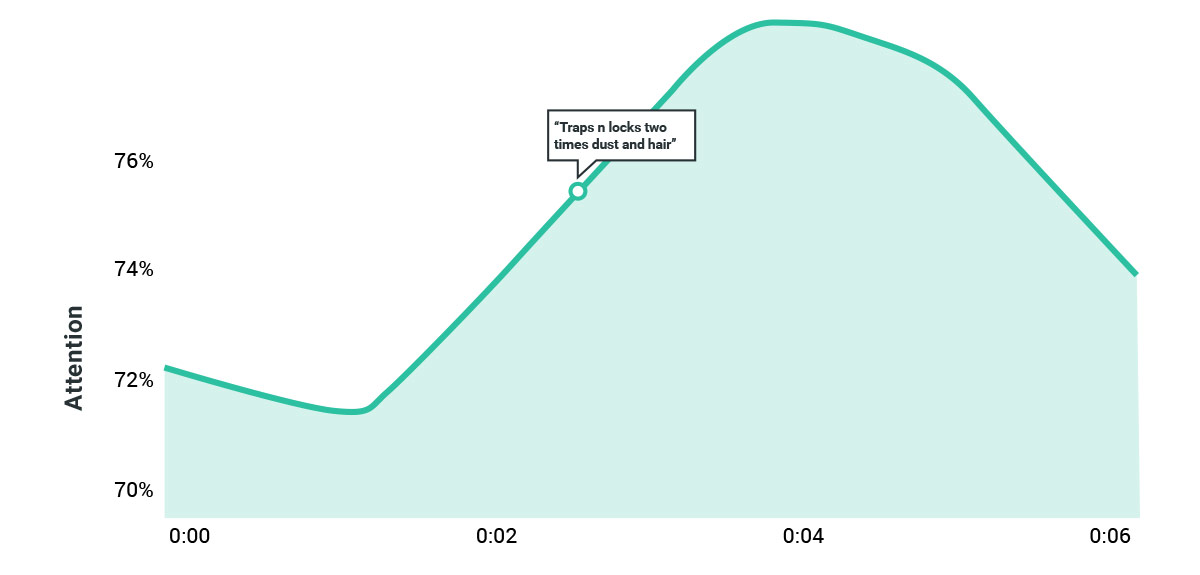
Shorter Ads Achieve Higher Attention
Encode, which is a measure of emotional response while paying attention, was 40% higher for 6-second ads versus 15-seconds ads. On mobile, Encode scores were 63% higher for 6-second ads versus 15-second ads.
In our portfolio of cleaning-goods ads, every second added to an ad decreased the attentive audience retention by 2.8% The ability for brand messaging to retain attention, create emotional response and memorability, increased with shorter ads. This phenomenon plays to this category’s advantage; it’s easy to demonstrate a quick cleanup. The strength and length of the product demo is the variable to consider.
every second added to an ad decreased the attentive audience retention by 2.8%
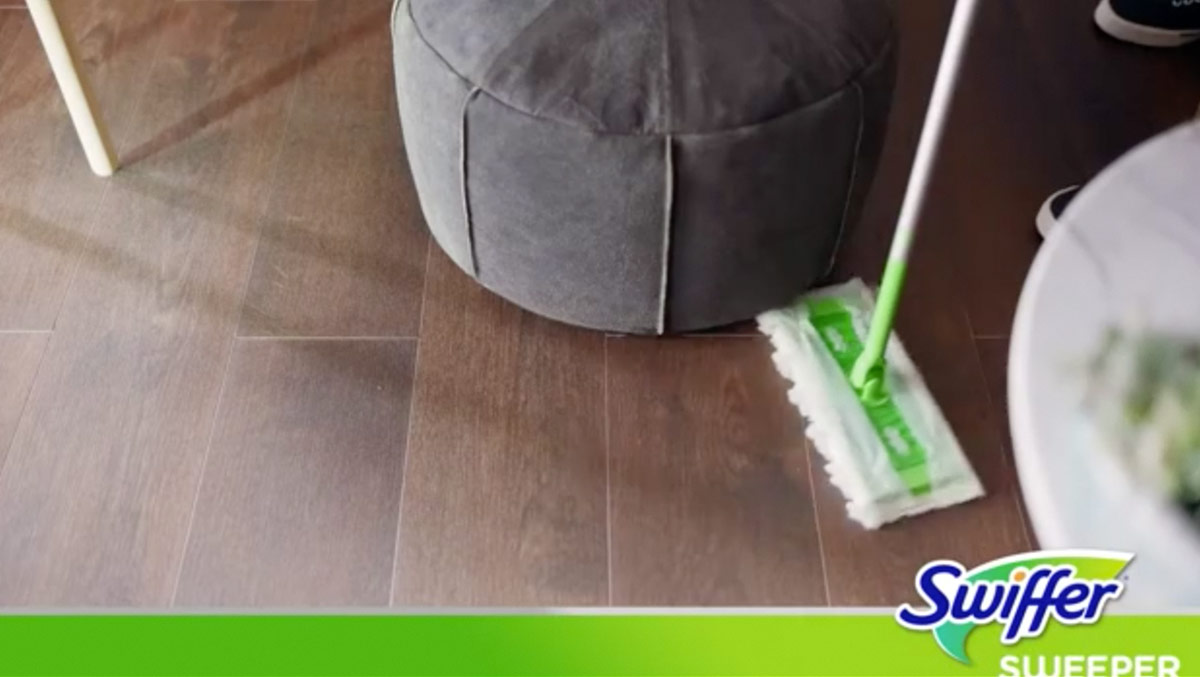
Top Scoring Ads
| Brand | Creative | Context | Duration | Quality Score | Capture | Retain | Encode | Efficiency | qCPM | |
|---|---|---|---|---|---|---|---|---|---|---|
| Swiffer | Sweeper in Action | Desktop | 0:06 |
9 |
6.0 | 51% | 82.5 | 90% | $11.07 | |
| Tide | Wash Your Dish Towel | Desktop | 0:06 |
9 |
5.9 | 50% | 90.3 | 87% | $11.51 | |
| Bounty | Clean Hands | Mobile | 0:06 |
7 |
6.0 | 52% | 5.4 | 70% | $14.32 | |
| Dawn | Antibacterial Hand Soap | Mobile | 0:06 |
7 |
6.0 | 55% | 1.6 | 70% | $14.29 | |
| Tide | Wash Your Dish Towel | Mobile | 0:06 |
7 |
6.0 | 53% | 2.0 | 70% | $14.36 | |
| Cascade | Do It Every Night | Desktop | 0:06 |
7 |
4.9 | 47% | 85.2 | 64% | $15.58 | |
| Tide | Don't Forget to Wash... | Desktop | 0:06 |
7 |
5.1 | 47% | 76.1 | 67% | $15.01 | |
| Bounty | End Tag | Desktop | 0:06 |
7 |
5.1 | 46% | 98.5 | 66% | $15.26 | |
| Finish | Skip the Rinse | Desktop | 0:06 |
7 |
5.1 | 46% | 96.5 | 65% | $15.40 | |
| Clorox | On the Go Office | Desktop | 0:15 |
7 |
5.3 | 23% | 87.8 | 69% | $14.60 | |
| Finish | Scrape Load | Desktop | 0:15 |
7 |
5.3 | 23% | 86.7 | 69% | $14.48 | |
| Dawn | Platinum makes quick... | Mobile | 0:15 |
7 |
6.8 | 29% | 7.6 | 69% | $14.41 | |
Quick Results, Demonstrations and Declarative Statements Drive Attention to Cleaning-Goods Ads
Ease of Use & Quick Results
Actors demonstrating how effective the product is and showing the end result both pique audience attention. In these examples, the dotted line indicates the key moment that demonstrates how effective the product is.
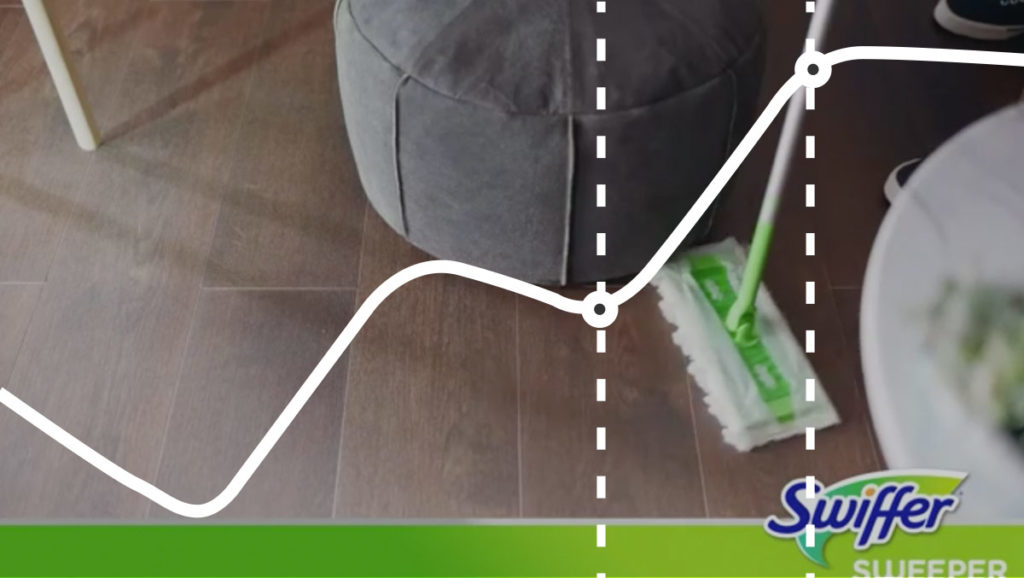
Swiffer - ‘Sweeper in Action’
As the product glides across the floor, sweeping around tables and getting into corners, it turns the floor from dull to a clean shine yielding the highest peak of audience attention.
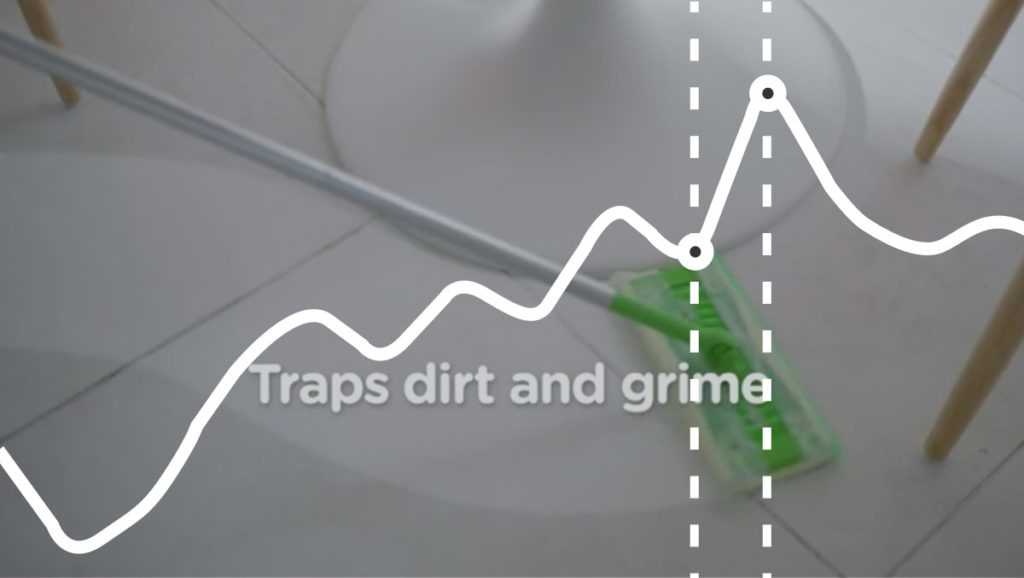
Swiffer - ‘Leah's Cleaning Confession’
This ad was a mid-performer with an overall Quality Score of 5. However, the moment of product effectiveness, similar to the other Swiffer example, creates a spike in attention.
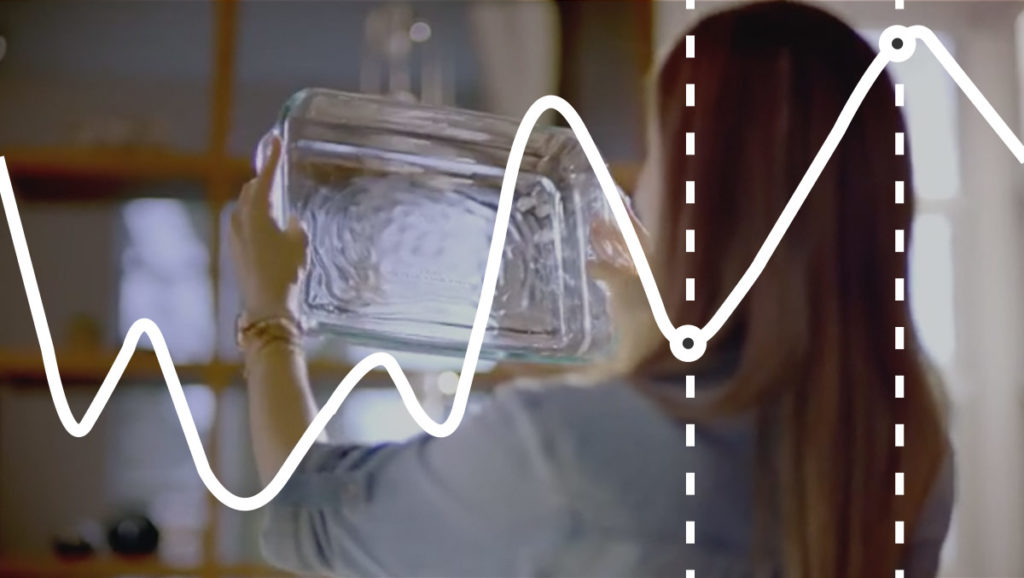
Finish - ‘Scrape Load’
Following a significant drop in attention due to the long packshot scene, it recovers significantly thanks to the results sequence as the dish is held up against the sunlight and sparkles.
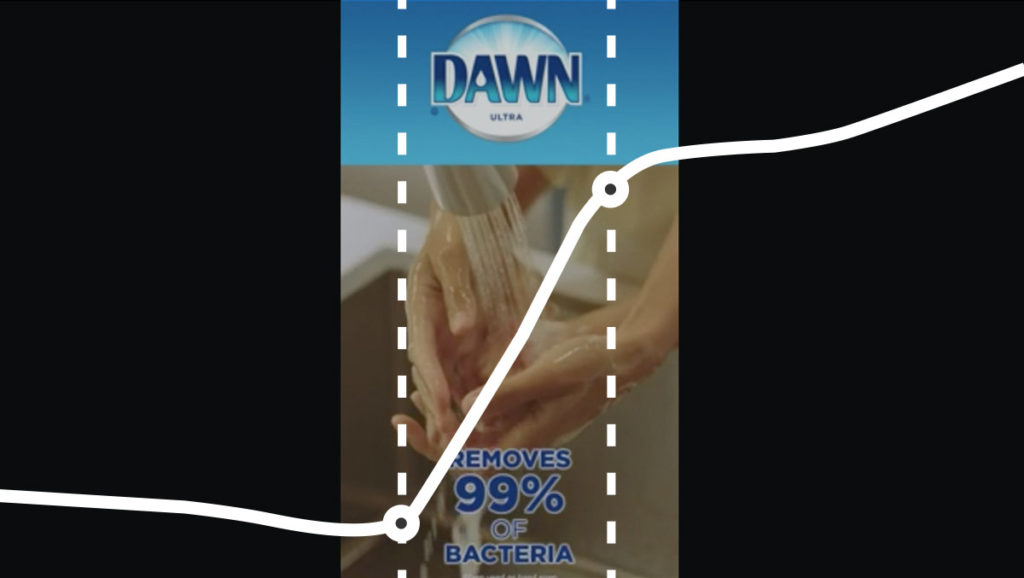
Dawn - ‘Antibacterial Hand Soap’
Following a packshot scene, the significant lift in attention is driven by the product quickly cutting through the grease as the hand swipes the plate. Attention continues to rise at a lower rate during the slow hand washing scene.
Proof Points
Technical demonstrations, whether they’re split-screen comparisons against the competitor or 3D animations to illustrate and substantiate effectiveness, all create key moments that peak in attention.
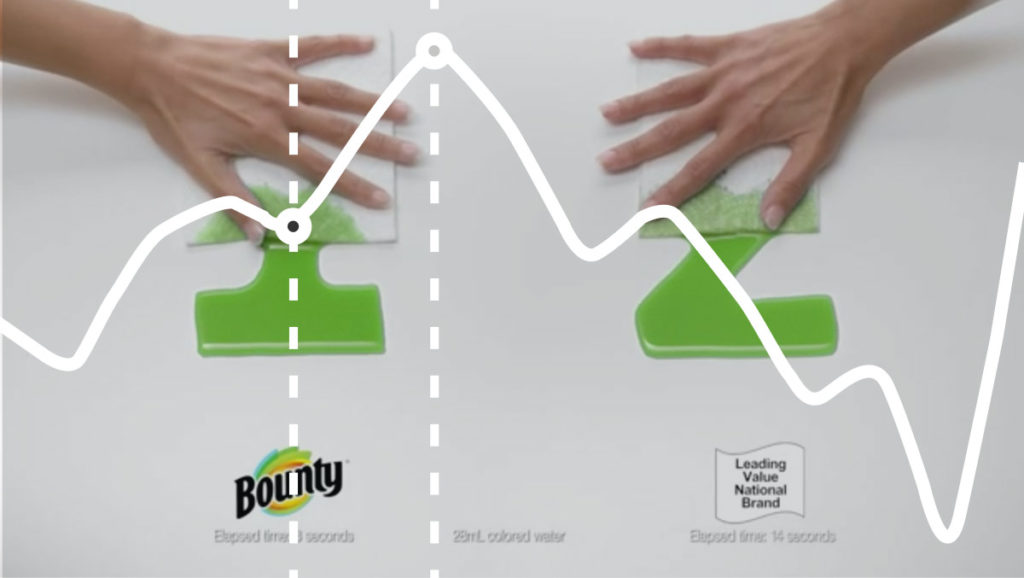
Bounty – ‘Versus’
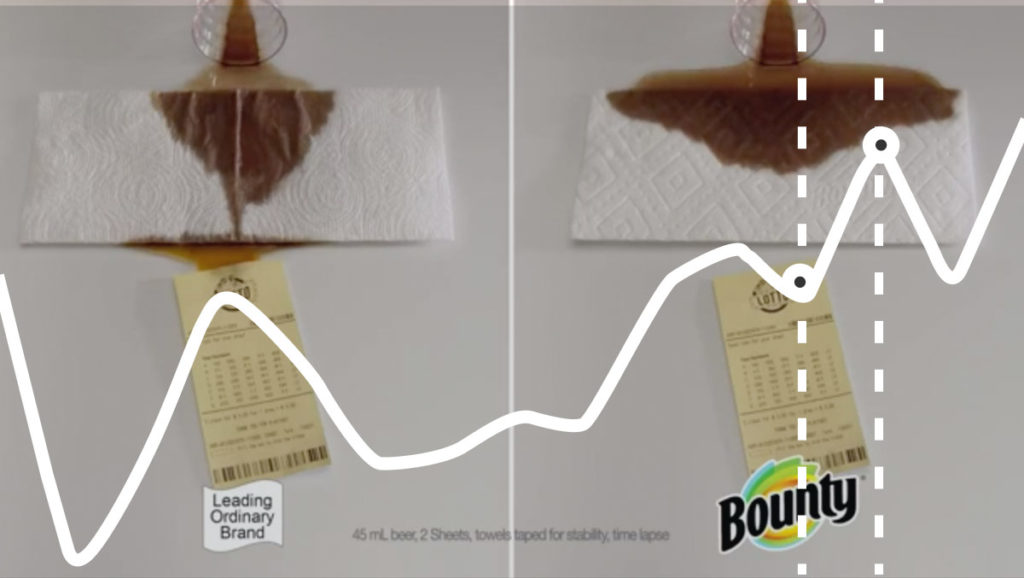
Bounty – Lottery
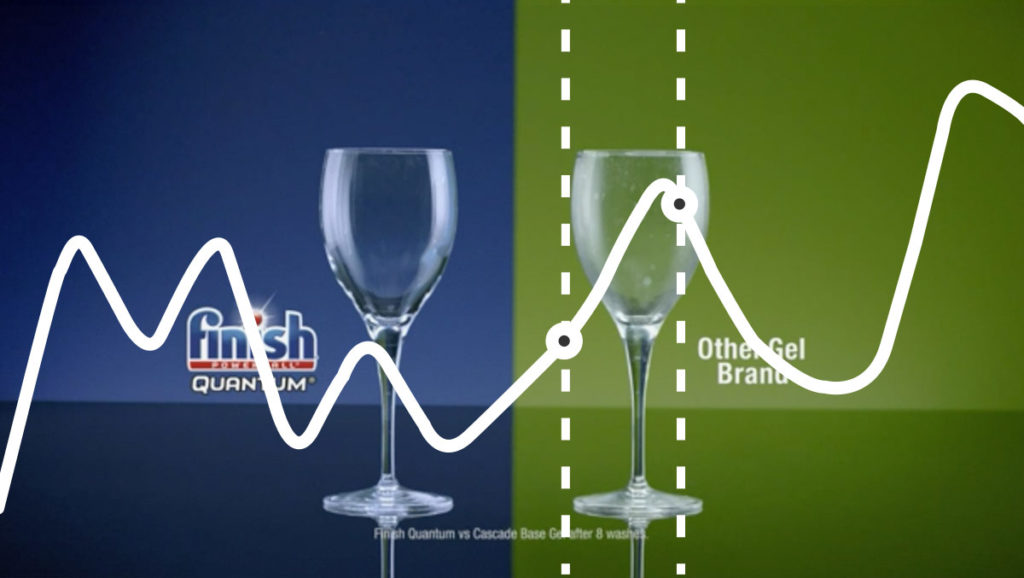
Finish Quantum - ‘Shine On’
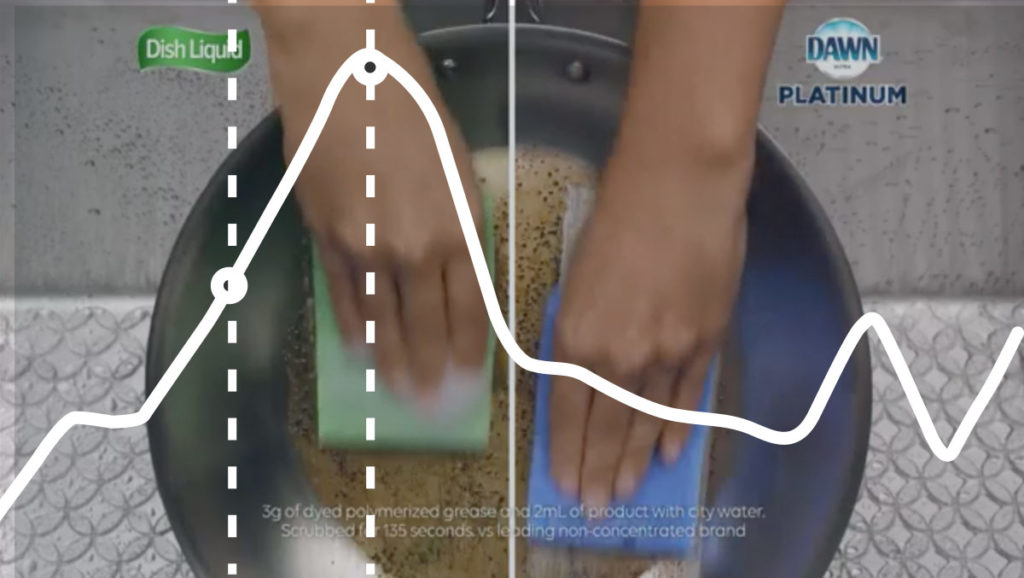
Dawn Platinum - ‘Makes Quick Work’
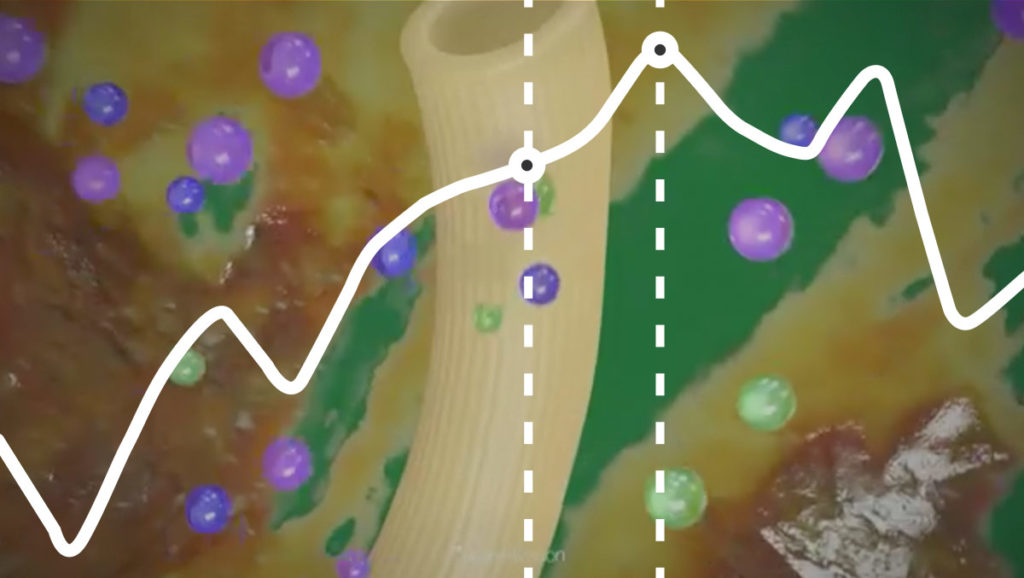
Cascade - ‘50% More Cleaning Power’

Finish - ‘Machine Cleaner Sink’
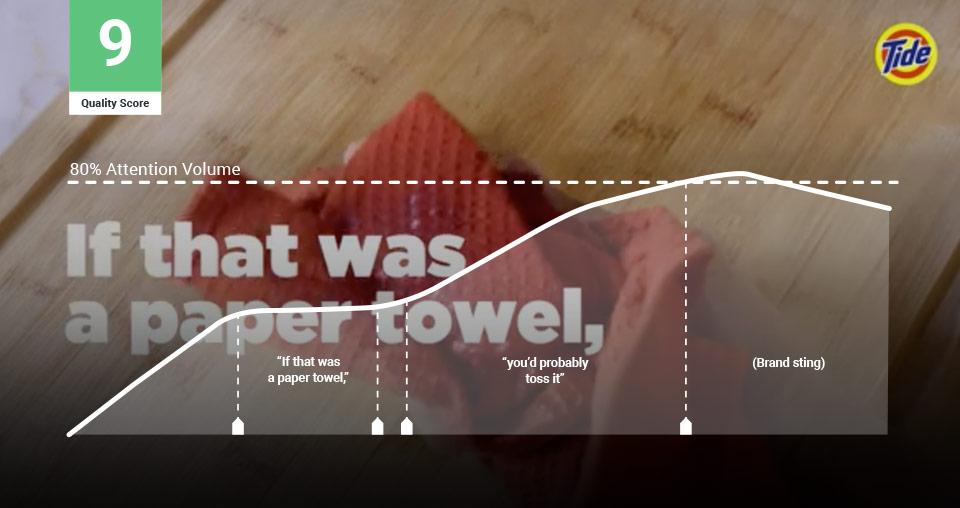
Declarative Statements
Attention rises when bold typographic statements, synchronized with the narrator’s delivery punctuates the message. This graphic device transforms what would be B-roll footage of cleaning and wiping down into attention-grabbing content.
Tide makes a feature of this technique, giving a significant proportion of real-estate to messaging combined with the narrator’s voice. In its ‘Wash Your Dish Towel’, the message is delivered in two statements “If that was a paper towel,” followed by, “you’d probably toss it.” The set-up line holds attention, while the second pay-off line is significantly rewarded with attention.
...transforms what would be B-roll footage of cleaning and wiping down, into attention-grabbing content
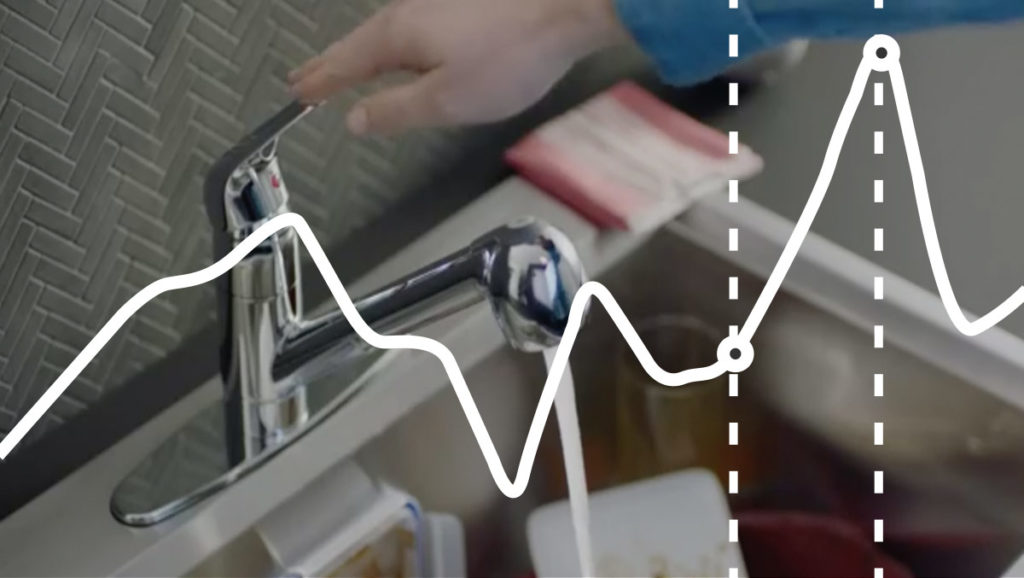
Dawn – ‘Disinfecting Wipes’
Dawn’s ‘Disinfecting Wipes’ pulls out “Kills 99.9% of Bacteria and Viruses,” piques audience attention.

Clorox - ‘On the Go Office’
Clorox ‘On the go’ employed large capitalised text in the center of the frame: “DISINFECT” followed by “ON THE GO.” both raised attention levels, giving the different clips of a hand wiping down different office surfaces something to which to anchor.
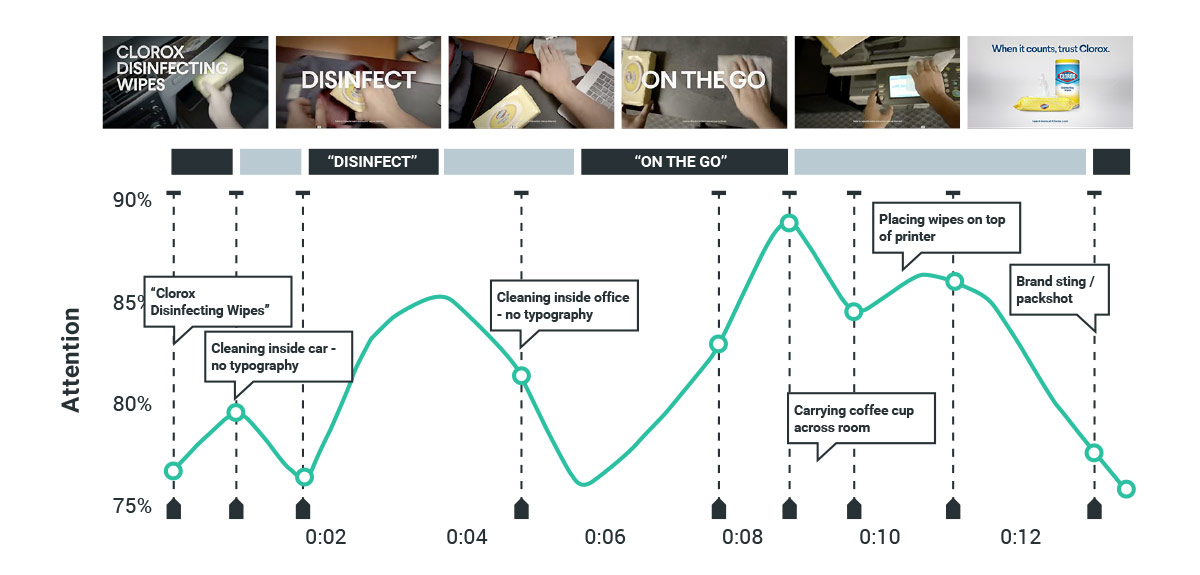
Similarly, Cascade’s ‘Dry Dishes After Every Dishwashing Cycle’ used “CLEAN. DRY. DONE.” delivered in bold staccato statements which work hard to salvage the two earlier drops in attention (creating the W shape in attention volume), triggered by two product-shot sequences.
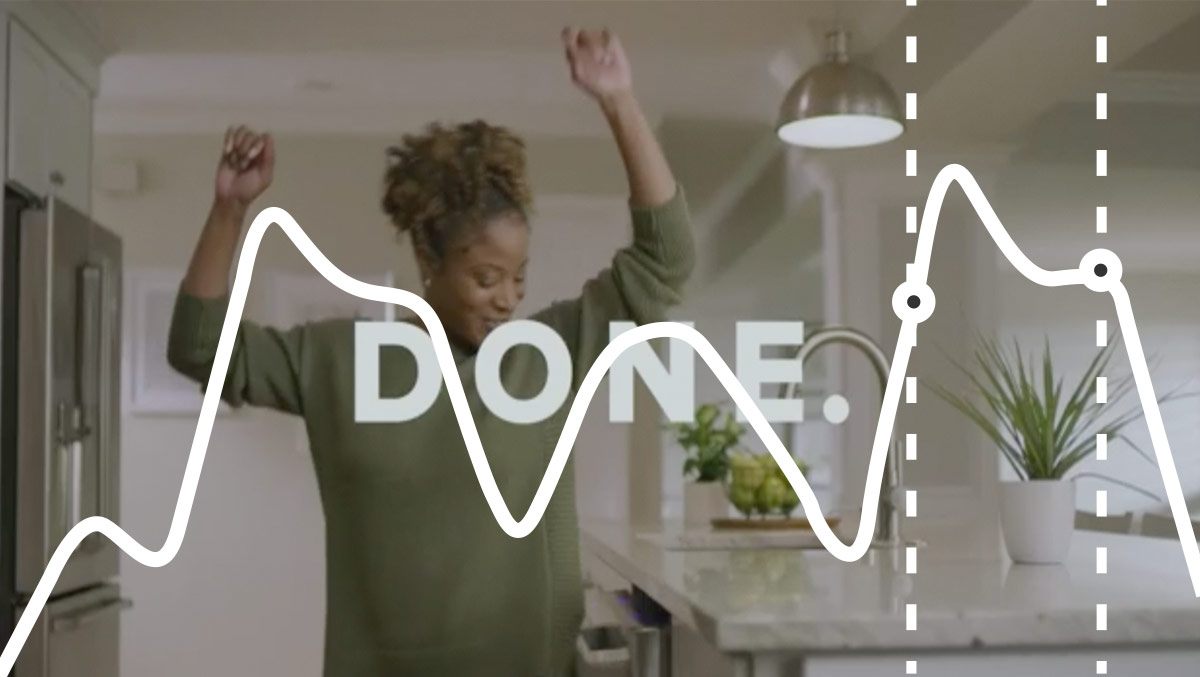
Cascade – ‘Dry Dishes...Every Cycle’
Mobile Demands Tailored Creative to Match Attention of Desktop
Mobile ads have the advantage of placing the creative directly under the nose of its audience and ordering is only a click away. That said, the viewer can easily be distracted by competing audio and visual content, notifications, the desire to switch apps along with forces outside the device context too.
The quality of the ad-viewing experience for mobile is different from desktop, as shown by differences in the audience attention levels and emotional responses.
Our portfolio of cleaning ads performed better on desktop than mobile based on most of Realeyes’ creative attention metrics. For example, the same ads viewed on desktop had an average Quality Score of 4.8 out of possible 10, versus 3.8 on mobile.
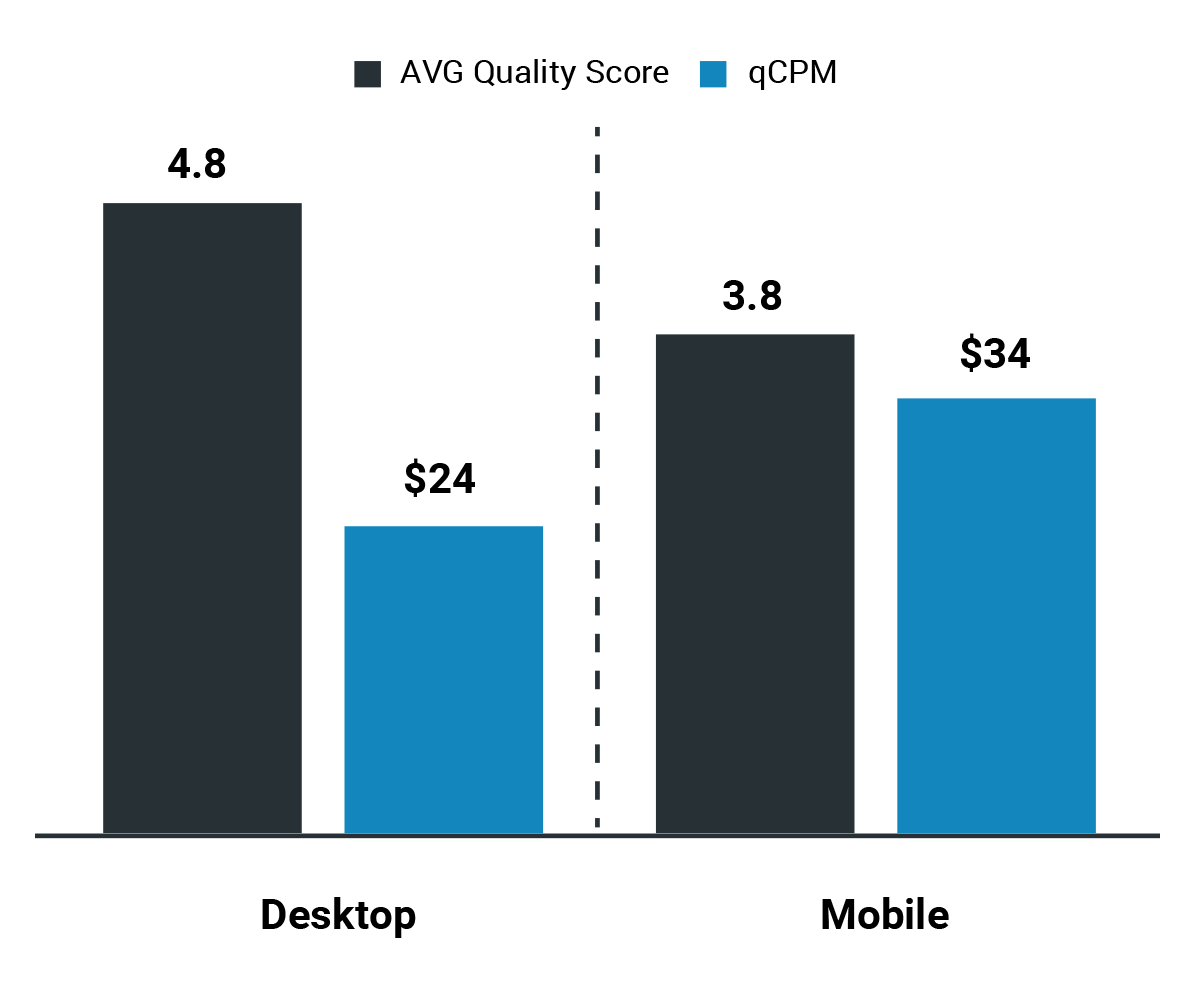
This means ads are less efficient on mobile for every dollar of paid media. Realeyes uses a metric, qCPM, which identifies the effective cost per quality exposure for any ad. Assuming an average nominal CPM of $10, the qCPM for desktop was $24 versus $34 for mobile.
In terms of maximizing each dollar spent on paid media impressions, the average Creative Efficiency for desktop was 48% versus 40% on mobile.
Additionally, brands struggled to create an emotional response when panelists viewed ads on mobile. The average Encode score was 58 (index from 1-100) for desktop videos and 6 for mobile.
As people increasingly view content on the go, mobile must remain a priority, especially for reaching and reminding people to buy at the right time and place (i.e., shopping or approaching a task that involves cleaning). Mastering mobile creative is critical.
The best ad on mobile in our portfolio, according to attention performance, was Dawn’s 6-second ad, “Antibacterial Hand Soap.” The ad showed a greasy pan, a hand with a sponge cleaning it, and then a pair of hands washing under the faucet and the product. It had a Quality Score of 7 out of 10 on mobile. This creative was more tailored for a mobile environment and did not perform as well on desktop with a Quality Score of 3.
Another ad, Bounty’s “Clean Hands,” performed well on mobile. It showed a young girl washing her hands and reaching for Bounty paper towels as a voice-over tells her to skip the dirty hand towel (at which she looks at briefly). Similarly, it scored 7 on mobile, 3 on desktop.
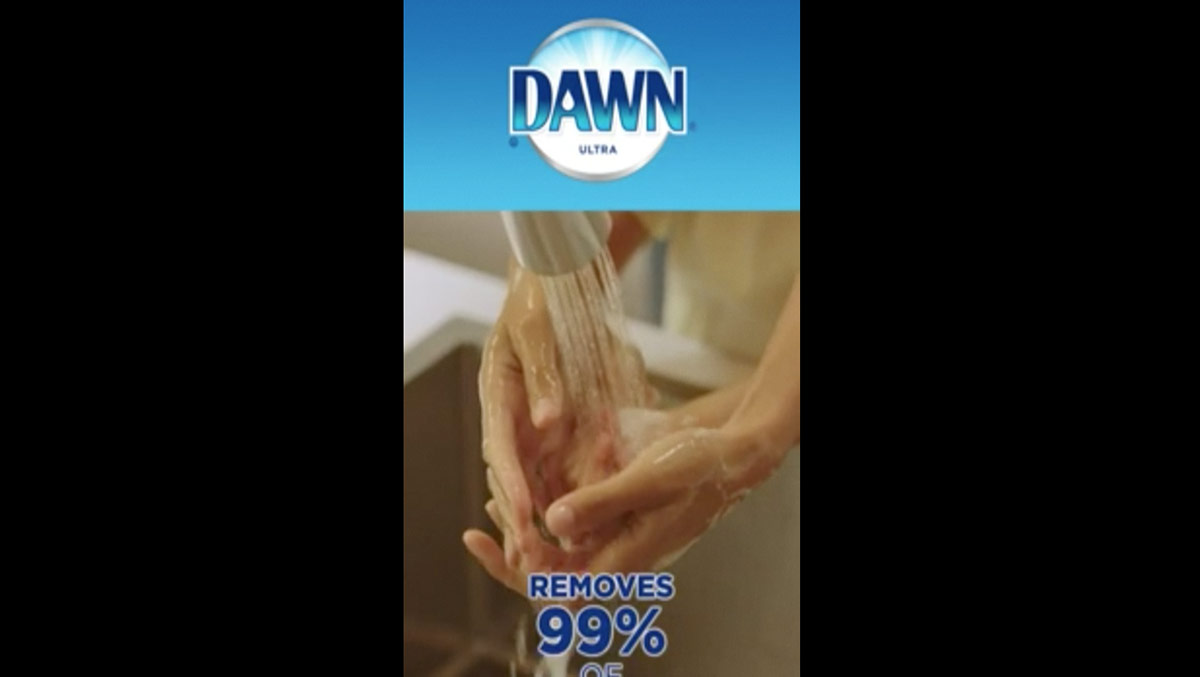
Dawn – ‘Anti-bacterial Hand Soap’
Ads Require Adaptation to Maximize Mobile & Desktop Performance
Ads were more likely to have significant scoring differences between mobile and desktop. Sixteen of our 42 ads had a ranking difference of 20 places between mobile and desktop on Creative Efficiency and qCPM.
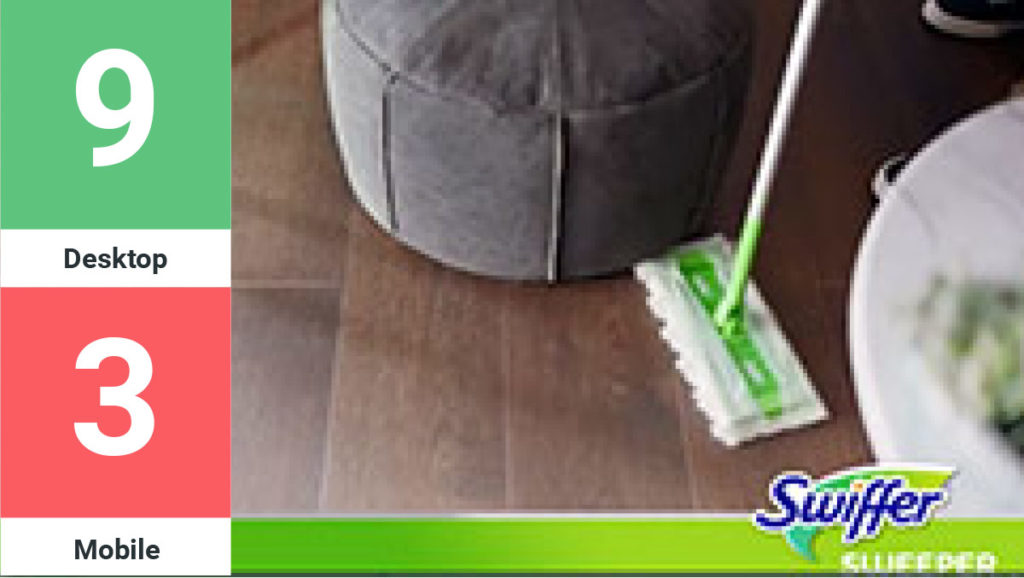
Finish Quantum - ‘Shine On’
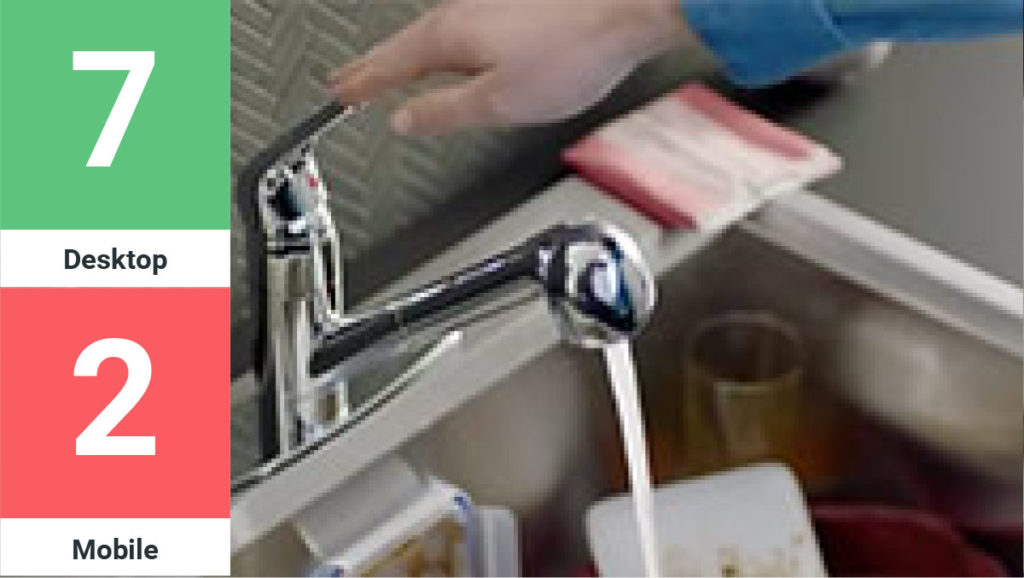
Dawn Platinum - ‘Makes Quick Work’
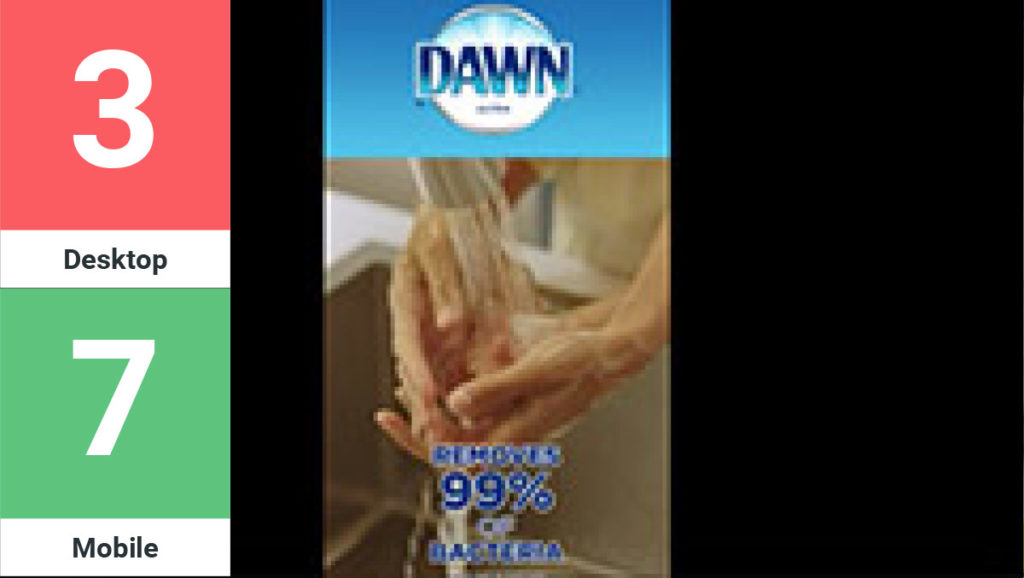
Finish Quantum - ‘Shine On’
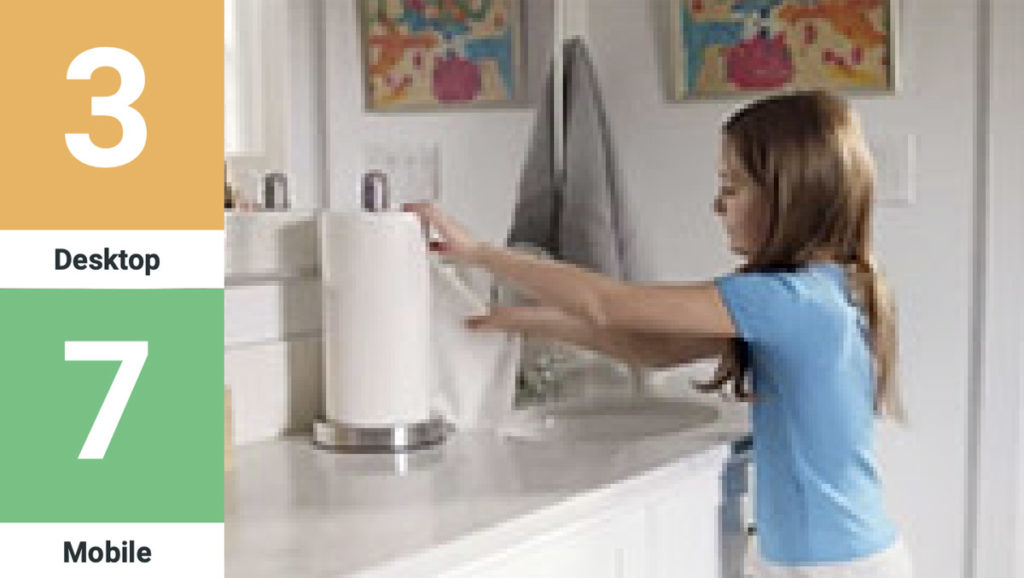
Dawn Platinum - ‘Makes Quick Work’
Conclusion
YouTube is a powerful platform for all brands because of its reach and ability to drive results. And while DTC brands have long embraced YouTube as a performance marketing vehicle, companies in industries with latent demand can optimize for creative attention and emotional response.
Here are some actions brands in the cleaning goods and broader FMCG categories can take today to improve their ability to drive attention and emotional response.
- Optimize for desktop and mobile, as creative in these categories will often perform differently for both
- Always pre-test creative before any new campaign (even for creative that you previously tested)
- Prioritize shorter ads and more direct messaging to drive greater attention and emotional response
- Rethink creative decisions that repel attention (such as a long setup of failing to clean properly with a substandard competitive product)
- Show effortless work; do not remind people that cleaning can be a chore.
Methodology
Realeyes sought to understand creative attention performance within the FMCG category, and more specifically, the home cleaning goods subset. The Realeyes Quality Score used in this study is part of Realeyes’ flagship PreView product, a content intelligence tool for predicting and managing attention in advertising. PreView enables advertisers to reduce media waste by predicting and eliminating low-performing video creative and boosting strong attentive creative.
PreView has achieved up to 30% performance gains and 9X return of investment based on an ROI model involving 51 actual consumer goods ads.
Quality Score is reported on a scale of 0-10 and measures a video’s ability to perform in market. It includes three critical elements:
- Capture: Ability to capture audience attention in the first seconds.
- Retain: Ability to retain the audience throughout the ad.
- Encode: Ability to encode the brand message into the brain through emotional engagement.
We tested in September 2021 six ads each (three 15-second ads and three six-second ads) from seven cleaning supply brands for a total of 42 unique videos. One panel viewed the videos on mobile and the other on desktop. The total number of video tests was 84. The brands selected were Bounty (P&G), Cascade (P&G), Clorox (The Clorox Company), Dawn (P&G), Finish (Reckitt), Swiffer (P&G), and Tide (P&G).
Each brand and ad was tested equally against both desktop and mobile panels. The Desktop panel viewed the ads 6,783 total times versus 6,644 total views for mobile for an average of 160 views per ad for each respective panel.
- Duration of videos was classified across three groups: :06 [42], :12 [2] and :15 [40]
- Brands were given the same treatment in terms of duration [Average of 10.5 Seconds per video per brand]
- We analyzed Realeyes’ performance metrics against several dimensions:
- Duration
- Brand
- Device Presence of Brand
- Percent. of Time Presence of Brand
- Presence of Product
- Percent. of Time
- Presence of Product
- Presence of Human
- Percent of Time
- Presence of Human
- Presence of Product
- Human Interaction
- Pct. of Time Presence of Product Human Interaction
Contents:
- Introduction
- What you need to know
- Human Presence Retains Attention, While Human Behaviors Elicit Key Emotions
- Swiffer
- Shorter Ads Achieve Higher Attention
- Quick Results, Demonstrations and Declarative Statements Drive Attention to Cleaning-Goods Ads
- Mobile Demands Tailored Creative to Match Attention of Desktop
- Ads Require Adaptation to Maximize Mobile & Desktop Performance
- Conclusion
- Methodology
Share this:


